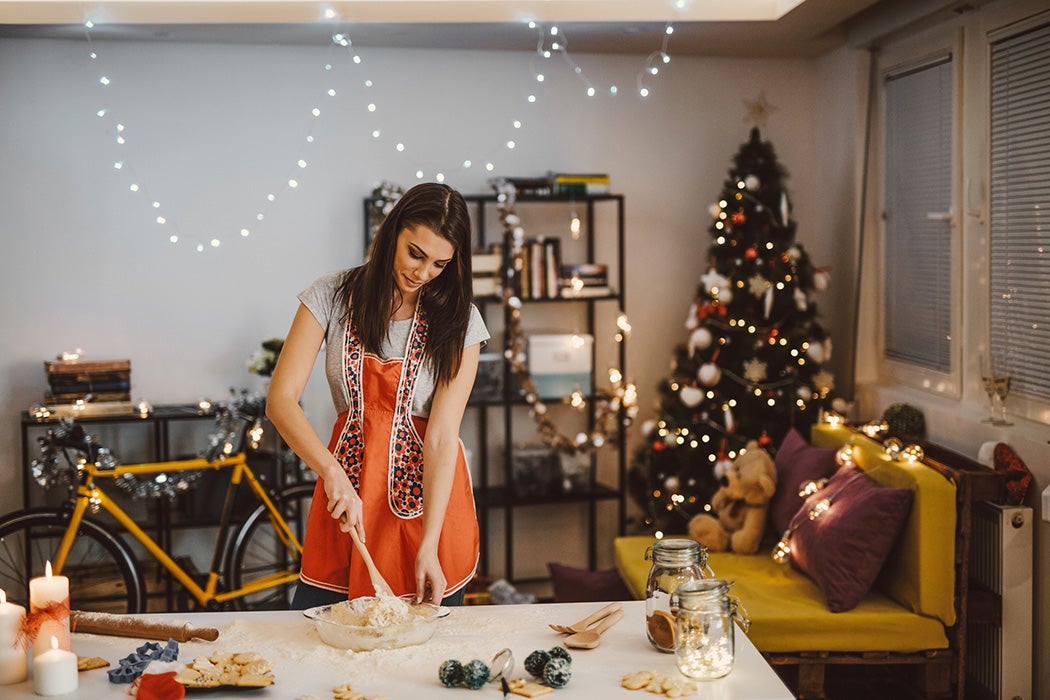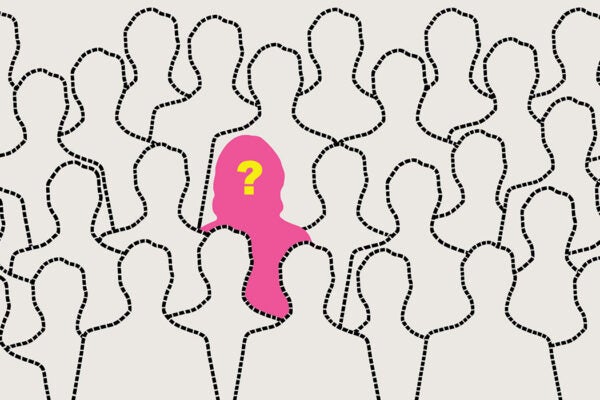Happy holidays! It’s that special time of year to gather with cousins, nephews, and in-laws, as we wear ironic sweaters, drink mulled wine, and reinforce traditional gender roles.
Women in heterosexual relationships still do the lion’s share of the housework. During the holiday season, the tasks multiply. On top of the everyday work of cooking, cleaning, and organizing, there’s the added shopping, trip-planning, and party-throwing. In 2015, Judith Shulevitz, a journalist and author of The Sabbath World: Glimpses of a Different Order of Time, wrote about the “worrier” role of women. Essentially, Shulevitz argues, even if men and women seem to distribute housework evenly, women are still in charge of “managing” the home, resulting in increased pressure and anxiety.
“You could call it the ‘triple shift,’” Shulevitz tells me. “The holiday shift.”
Michelle Janning, a sociologist and professor at Whitman College, studies how contemporary families define themselves through domestic objects––photograph displays, decorations, etc.––and spaces. She calls these displays “the taking and managing of the family story,” which, she notes, women feel responsible for. Research bears this out. Although men and women perceive cleanliness equally, an unclean house evokes more anxiety in women. And during the holidays, Janning tells me, the presentation of the home is “more visible, and has a heightened meaning attached to it.”
“The worrying about the Christmas picture or card is more likely to happen with women––and the responsibility of sharing it outside of the family is more likely to fall on the shoulders of women,” Janning explains. “Like creating a Shutterfly album, or making sure the address list is up to date.”
Weekly Newsletter
A 1990 study examined the different ways men and women perceive holiday shopping. Women in the study felt “compelled to do the ‘work,’” which often involved “kin-keeping,” or maintaining social ties. Christmas shopping was determined to be “women’s work:” they were the primary gift-givers and spent more on shopping than men. According to the study, “women appear to be socialized to take it quite seriously as real and important work.”
Thirty years later, Christmas labor still seems to be considered “women’s work.” “The amount of time spent and money spent [on Christmas],” Janning tells me, “is a gendered thing.”
And in a 2017 study of kinkeepers, conducted by Dawn O. Braithwaite at the University of Nebraska-Lincoln, 91 percent of self-identified kin-keepers were women. “For women who are already stretched thin during the holidays, as so many of these activities converge at once,” Braithwaite wrote to me, “kinkeepers would likely be stretched even more.”
* * *
The pressure of kin-keeping is heightened in families with children. A lot of childless couples seem to distribute household labor and even the kin-keeping labor more equitably. But even as married women and mothers may feel a greater pressure to project the image of the ideal household, single women are not immune. When it comes to planning parties and decorating the home, single women invest more time than single men. The same goes for housework.
“It’s not just getting married that makes them do this,” Stephanie Coontz, director of research and public education for the nonprofit group Council on Contemporary Families explains. “They’re socialized at a very early age. Girls are given more chores around the house and paid a lower allowance than boys are, even now.”
Janning agrees. Decorating your space, she says, is “still something that women want to do, feel the pressure to do, stress out about––and then do.”
“The representation of your home as a beautiful place is still prioritized for women,” she says.
Same-sex couples generally tend to carry out housework evenly. “The real unevenness,” Coonz says, “is in heterosexual couples.”
* * *
It’s important to note that the tradition of family gatherings during the holidays is relatively recent. In the seventeenth and early eighteenth century, Christmas was more a time for celebrating with neighbors than a family occasion, Coontz tells me. The roles of men in society required interpersonal connections, which meant that they organized social gatherings.
The nineteenth century saw “a much more bureaucratic world, politically and economically,” Coontz says, where “personal ties are separate from political and economic ties––men take care of political and economic ties, the breadwinning. And women come to take over the interpersonal relations––the kin-keeping, social-networking with neighbors and friends.”
Making sure the home looks good, for instance, “is still a woman’s responsibility, and during the holidays, that expectation is notched up,” Janning tells me. “You’re more likely to have spaces in your home on public display. You’re more likely to have things come out of storage that you need to organize, display, curate. You’re more likely to have an event where there’s a hosting duty, food and drink, all that. There’s a heightened amount of labor.”
And in the age of Instagram, the presentation of our homes and families takes on an increased importance. During holidays, Janning says, we share more images focused around this representation of ourselves and our families. “If you add that the holidays are a difficult time emotionally for many people, it makes a lot of sense for me to believe that the difficulty of this season, emotionally, is heightened,” she says. “And if you have groups with different stress levels, it’s heightened for women.”
* * *
However uneven the playing field is, we should not view women simply as victims of these circumstances. In fact, many women report pleasure in engaging in holiday activities. And “even in the most liberated households, it’s hard to escape the kind of relentless pressure that accompanies these seemingly charming rituals––who doesn’t want to do things like decorate the house or stuff like that?” Coontz says. “But they certainly bring with them all the baggage of those old expectations.”
“It is real emotional work and the pleasure is accompanied by much more stress than the men feel,” Coontz says. There’s a pressure, she explains, that comes from “the tremendous weight of 150 years of being told that this is our special skill, our special contribution to family life and community life, which can be very gratifying––and which is why women hold onto it very often.”
Some of it comes from the “gatekeeper” role that women often adopt. Even when the work is anxiety-inducing, women may still want to be recognized for our “special authority.” And this ambivalence is heightened around the holidays.
* * *
Times are changing. More women are telling their partner, “I want you to share this with me,” Coontz says. And single men are responsible for maintaining their own social relationships. Also, married men are taking much more responsibility for shopping.
But even when women report getting joy out of holiday labor, there are reasons to question it. Female friends often tell me that their male partners just aren’t as good at this work as they are––that they do it partly because it would cause more stress to hand over the tasks. But, as Coontz points out, “we will be a lot better off when we can begin to trust men to do these things. Just as we let kids set the table wrong in order that they learn to do it, we need to let go.”
“If your male partner has been infantilized that way by his mother and by a hundred years of socialization, then let them screw it up one time,” she says. “You know, he’ll learn.” She adds that, “sometimes we women might even learn from the different methods that men use as they gain more experience doing these tasks.”
Another reason to correct the balance is that couples are happier when the perceived breakdown is viewed as equitable, according to Daniel L. Carlson, an assistant professor in the Department of Family and Consumer Studies at the University of Utah. For one thing, couples that view the division of labor as equal tend to have more satisfying sex, his research shows.
But since most couples do not divide the work evenly––only about three couples out of ten do, Carlson says––the workload during holidays is “likely to exacerbate current patterns in relationships.” As women do end up doing more work during this time, however, he suspects it does not mean that the couple will correct the imbalance. “Most likely,” he tells me, “it will reinforce divisions that already exist.” Carlson offers an explanation: “In the face of normative pressures, people tend to retreat to traditions.”
Dividing work according to traditional gender roles isn’t necessarily a problem––if everyone is on board with the arrangement. But the problem, Carlson says, is that “the vast majority of women don’t want to do it this way.” If a man, for instance, insists that his partner enjoys the work, it’s possible that the couple’s communication skills are lacking.
Shulevitz views the issue in broader terms. “Women should be paid for the work they do,” she argues. “It’s just as valid and important, and in some ways more important, than what people do in the marketplace.” The unpaid work, mostly by women, produces value that, she says, is not calculated in our gross domestic product––and that should be corrected. Carlson adds to this, saying that it’s often a struggle for couples in the U.S. to achieve a fair division of labor, since “there’s little or minimal structural or cultural support for it.”
Christmas labor is more clearly visible than the year-round work that women are doing. But “it’s the day-to-day,” Shulevitz says, “that doesn’t get noticed.”







